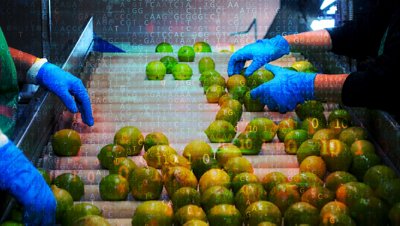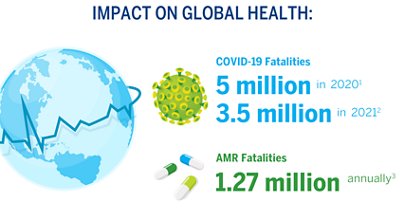Data and the Food Industry: From Field to Table
By the bioMérieux Editors | Reading time: 4 min
PUBLICATION DATE: JULY 07, 2023
As new and emerging technologies drive an unprecedented speed of change across all business sectors, it is expected that the food industry will evolve more over the next decade than it has done in a generation.
Data science is opening opportunities to improve food sustainability, safety and security; meeting the nutritional needs of a growing global population, whilst also aiming to reduce the impact of food production on natural resources and the environment. These trends have led the World Bank to go so far as to state that digital technologies will empower greater transparency of agricultural value chains, drive smarter farms and, ultimately, enhance public services.
Furthermore, data-led risk-assessment approaches offer an important alternative to animal testing – a method that food companies and industry bodies alike are increasingly moving away from. The European Food Safety Authority (EFSA) for example, has announced it is going to move towards mechanistic risk assessment, using non-animal-based approaches for hazard and exposure assessment.
We want to reflect on how data is helping to tackle some of the biggest challenges facing the food industry today and where it can underpin this anticipated ‘food revolution’. So, let’s explore four critical areas where data can be used to improve standards from ‘field to fork’.
Food security and sustainability
Global food production and supply chains are impacted by the results of population growth, including the effects of climate change and the loss of arable land.[i] Inversely, the direct impacts of food production on the environment cannot be denied, with our food system being responsible for between 21% and 37% of global greenhouse gas emissions.[ii]
Evidently, there is a need to more effectively balance the world’s food security needs against achieving environmental sustainability. One way in which data can support this aim is through improving our understanding of the nutritional needs and carbon emissions of specific crops, enabling food producers to adjust their usage of fertiliser (a significant contributor to greenhouse gas emissions associated with agriculture) and allowing them to make evidence-based decisions, considering potential yield versus environmental impact. Data can also provide insights into the genetic information (DNA) that is released from an organism into the environment, allowing producers to more easily identify emerging pests, pathogens or other ecosystem threats, and support improved crop management practices and efficiencies.
Smart use of previous sales data can also be combined with other relevant insights, such as average consumer income, to deliver more accurate predicted product sales figures in local areas before goods have been shipped. By working from these predictions and only supplying and transporting what is needed, food producers have the opportunity to both limit food waste and lower their transport-related carbon footprint.
At an individual level, data and technology also have a role to play in helping to shape eating habits and encourage consumers to make more sustainable choices. While food transportation does create emissions, most of the carbon footprint of our diet is based on what we eat and how it is produced rather than how far it has travelled.[iii] Consumer data can enable greater personalisation of targeted campaigns on channels such as social media, nudging consumers to try new, more sustainable alternatives. By growing demand over time, effective consumer marketing can ultimately incentivise food producers to invest more in sustainable products.
Food safety
Every year, one in 10 people worldwide will become ill from consuming contaminated food.[i] The World Health Organization (WHO) sees food safety as a shared responsibility across the whole supply chain, from producers to consumers. According to WHO, most cases of foodborne disease are preventable with proper food handling and education at all levels. Data provides the evidence needed to help maintain food safety despite changes to the production environment, processing technology and consumer habits.
Sequencing data can be used to monitor the genetic make-up of the microorganisms present within the food that we consume, including bacteria, viruses, fungi and single cell organisms (protozoa).[i] These data are used to identify and trace specific strains of microorganisms related to food safety outbreaks and reduce the risk of contamination in raw materials. Additionally, analysing the microbial populations in factories helps to determine whether cleaning protocols and procedures are effective.
Delving deeper into the science, sequencing data is typically gathered via sequencing of the entire genome of a microorganism (whole genome sequencing or WGS) or by focusing on specific genes or regions of the genome. This technology is used to isolate different species of bacteria, identify potential strains of threat and track foodborne pathogenic sources of contamination. When assessing food safety outbreaks genomic data can play a vital role in public safety. Such data can be used to identify which specific ingredient within a foodstuff has caused an outbreak, where the ingredient originated from and which processing facility it was produced at.
Advancements in next-generation sequencing technology have dramatically reduced the cost and increased the ease of conducting microbial WGS[iv]. However, the ‘holy grail’ of food safety surveillance and risk assessment is anticipated to be metagenomics – the sequencing of all genomes from members in a microbial community within a specific environment. The ability to monitor whole microbial communities rather than individual pathogens provides an “unparalleled opportunity” to control microbial hazards, reduce the incidence of foodborne illness and improve the profitability and sustainability of food businesses. Potential applications include pathogen detection, monitoring for resistant genes, quality control, screening for unauthorised genetically modified organisms, and detection of species fraud.
Food quality
Another important aspect of food production that can be supported by use of data is food quality control, which alongside safety can have an enormous impact on a brands reputation and credibility if compromised, as well as potentially endangering public health.
The food industry is strictly regulated, both by national governments and industry bodies, holding ingredient suppliers and manufacturers to the highest standards for the protection of consumers. Ideally, food producers should take all steps to ensure the highest level of food quality control and avoid recalls altogether by identifying issues before products are shipped. It follows that food quality is not something that can be assessed at a single stage of a production process but must form part of the whole chain – from initial development through to manufacturing and transportation.
Data analytics can help provide food manufacturers with greater control of their final product, helping them to understand which elements of manufacturing processes, as well as packaging and storage, have the greatest effect on quality and taste and effectively predict their impacts. By acting on these insights in real time, food producers can make adjustments to account for any potential changes and ensure ongoing consistency in the quality of their output.
Much in the same way as the pharmaceutical industry does, food producers can also use data to ascertain how the quality of their products changes and degrades over time, allowing them to establish which factors may affect the shelf life of a product and make adjustments where needed to counter these effects. Not only can these quality interventions potentially offer cost savings to producers and avoid potential quality issues, but they can also provide savings to the environment by preventing product waste.
Food traceability
As global supply chains within the food industry continue to evolve and grow in their complexity, traceability across these networks remains as vital as ever to accurately track and trace the paths of products, support food safety and security, and retain consumer confidence in the origin and authenticity of what they buy. Although rare, when food safety issues arise, traceability is key to protect public health and enable effective recalls, if required. In such situations, information is vital to mitigating risks to consumers and saving both time and money.
While the humble barcode is still an important tracking measure in the food industry, new data-led technologies are growing in prominence. With the US Food and Drug Administration expected to bring in updated legislation around maintaining records in food production, some companies are already moving to digital systems such as blockchain in anticipation. Currently more associated with its use to support bitcoin and other cryptocurrencies, blockchain can also be used to track and govern transactions. By enabling users to share a single set of data, blockchain can potentially reduce inefficiencies within the supply chain end enhance trust between stakeholders.
Widespread adoption of blockchain across the food industry may not be an imminent prospect, but early advocates in the private sector include Walmart and Nestle who have both introduced the technology to track parts of their food offering. The United Nations Development Programme has also called for further research into the potential uses of blockchain to support greater farm-to-table traceability in order to combat critical sustainability challenges in global agri-food supply chains.
In conclusion
According to a 2021 World Economic Forum report[i], whilst manufacturing executives consider advanced analytics to be critical for success, few are optimising the full value of data and analytics to address their most pressing challenges. With consumers ever more interested in every variable of the food chain, robust data capture on raw materials, the sustainability of production processes, and food quality/safety, will arguably be the prerequisite currency for the future of the food industry. Data is revolutionising the food industry from field to fork, and that’s here to stay.
Références:
- Environmental DNA Sequencing | Biomonitoring using eDNA (illumina.com)
- How digital technology can accelerate food sustainability. World Economic Forum. Available at: https://www.weforum.org/agenda/2022/09/how-digital-technology-can-accelerate-food-sustainability/#:~:text=Reducing%20food%20waste%20and%20enabling%20circularity&text=A%20transparent%20value%20chain%20offers,better%20match%20supply%20and%20demand.
- Hannah Ritchie, Pablo Rosado and Max Roser (2022).Environmental Impacts of Food Production. Published online at OurWorldInData.org. Available at: https://ourworldindata.org/environmental-impacts-of-food
- WHO. A guide to World Food Safety Day 2023: food standards save lives. https://www.who.int/publications/i/item/WHO-HEP-NFS-AFS-2023.6
- EFSA statement on the requirements for whole genome sequence analysis of microorganisms intentionally used in the food chain. 202. EFSA Journal. Available at: https://efsa.onlinelibrary.wiley.com/doi/full/10.2903/j.efsa.2021.6506
- European Centre for Disease Control & European Food Safety Authority et al. EFSA and ECDC technical report on the collection and analysis of whole genome sequencing data from food‐borne pathogens and other relevant microorganisms isolated from human, animal, food, feed and food/feed environmental samples in the joint ECDC‐EFSA molecular typing database. Technical Report 2019. doi:10.2903/sp.efsa.2019.EN-1337
- US FDA. Whole Genome Sequencing (WGS) Program. Available at: https://www.fda.gov/food/science-research-food/whole-genome-sequencing-wgs-program#Monitoring
- Billington C, Kingsbury JM, Rivas L. Metagenomics Approaches for Improving Food Safety: A Review. Journal of Food Protection. 2002 85(3): 448-464. https://doi.org/10.4315/JFP-21-301
- Data Excellence: Transforming manufacturing and supply systems | World Economic Forum (weforum.org)
You may be interested in these articles
SHARE THIS:
- Food Safety
< SWIPE FOR MORE ARTICLES >


